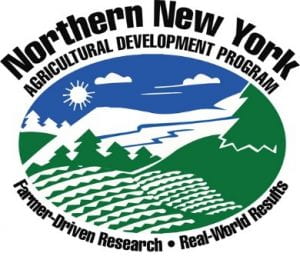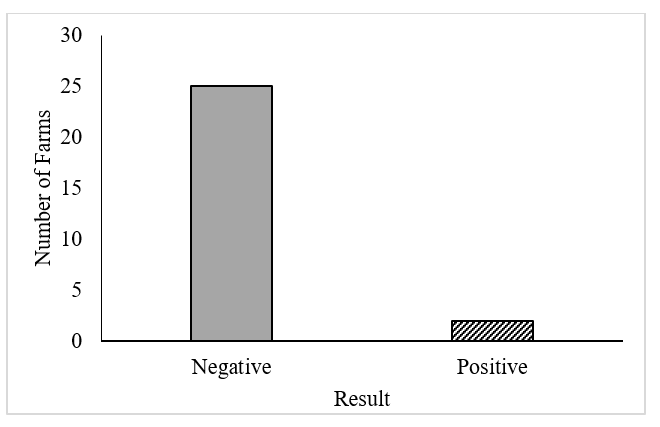Northern New York Agriculture Development Program 2019 Project Report
Project Leaders:
Lindsay Ferlito, Regional Dairy Specialist, CCE North Country Regional Ag Team
Paul Virkler, Quality Milk Production Services, SUNY Canton
Background:
Salmonella Dublin is a host-adapted bacteria that has the ability to greatly impact dairy cattle in the six northern counties of New York State, where dairying is a major economic engine for local communities and for the state. It generally shows up in young animals, specifically calves 6-8 weeks old, and it usually presents like pneumonia with calves having respiratory symptoms and a fever. In some cases, animals will have diarrhea, but this usually only occurs once the disease has progressed and the animal is critical.
Historically, Salmonella Dublin has only been considered a problem in western U.S. states, but over the last few decades it has crept across the country with more outbreaks being reported in the Northeast and Eastern Canada. The Cornell University Animal Health Diagnostic Center has been working to better understand the prevalence and impact of Salmonella Dublin across NY state. The current strain of Salmonella Dublin was first detected in NY in 2006. Since then, more than 140 cases have been documented on dairy, veal, and beef farms statewide. While the disease tends to be more prevalent on larger herd dairies, it can show up in herds of all types and sizes. Previous testing has indicated that multiple herds in Northern NY are already infected.
Salmonella Dublin is a very challenging disease; it is easily transmitted, hard to treat, and costly. The disease can be spread via fecal-oral, air, saliva and nasal discharge, and through colostrum and raw milk. Seemingly healthy adult cattle can be Salmonella Dublin positive and carriers that are actively shedding the disease.
Making this disease even more frightening for dairy farmers is its ability to spread between species. Farm workers and family members can also become infected with Salmonella Dublin, making them very ill. Once infected, the disease is difficult to treat as it is multi-drug resistant and it is suggested that 75% of the strains are resistant to at least one antibiotic.
Lastly, the economic losses as a result of Salmonella Dublin can be devastating. Treatment costs, calf losses, abortions, and reduced milk production can add up quickly and one study (Nielsen et al., 2012 and 2013) indicated potential losses of up to $350 per stall in the first year following infection.
It is important for NNY dairy farmers to be aware of this disease, including its risk factors and challenges, and to determine if it is present in their herd. The goal of this project was to determine the prevalence of Salmonella Dublin on dairy farms in Northern NY, and to understand the potential economic impacts it could have for individual farmers in this region.
Methods:
Dairy farms across the six-county region were contacted in various ways to enroll in this study, including in-person farm visits, phone calls, a newsletter article in the North Country Ag Advisor, through local CCE County staff, and through herd veterinarians. From these methods, a total of 27 dairy farms across five counties were enrolled and agreed to have bulk tank samples taken to test for the prevalence of Salmonella Dublin. These herds included both tie stall and freestall dairies, ranging from approximately 80 to more than 3,000 milking cows per herd. While the original goal was to have more participating farms, the project leaders were happy with this group as it included five counties and was a relatively representative sub-set of NNY dairy farms.
Herds were enrolled and agreed to have their data shared with their herd veterinarian. Over the course of six months, four separate bulk tank milk samples were taken from each herd. Before each sample was taken, a letter was sent to each farm notifying them of the sampling date. A Quality Milk Production Services technician then visited each farm to collect the bulk tank sample. All samples were shipped to the Cornell Animal Health Diagnostic Center in Ithaca, NY, for analysis. The test that was performed is an ELISA (enzyme-linked immunosorbent assay)-based test that measures the presence of antibodies to Salmonella Dublin in the milk sample. After each round of testing, the participating dairies and their herd veterinarian were sent a copy of their results.
After each round of testing, Quality Milk Production Services was sent a summary of the results indicating whether each participating herd tested positive or negative for the prevalence of Salmonella Dublin. After all four samples were taken, the results were compiled using Microsoft Excel. The results were analyzed to show the prevalence of testing positive as well as the frequency of positive tests over the four samples.
Results:
Overall, only two of the 27 herds tested positive for Salmonella Dublin during the bulk tank sampling (Figure 1). Of these two herds, one tested positive only once (and had three negatives), and the other tested positive in all four bulk tank samples (Figure 2).
Both of the herds that tested positive were not surprised as they have tested positive in the past with their own sampling via bulk tank or individual animal blood tests. Also, it should be noted that both herds that tested positive reported that they had used a vaccine specific for Salmonella Dublin in non-lactating heifers. Due to the fact that the test we used was an antibody detection test, it is possible that the bulk tank positive test was only picking up vaccine-induced antibodies. Unfortunately, there is no easy way to distinguish between antibodies due to natural exposure versus from a vaccine.
Figure 1. The number of herds testing positive and negative for Salmonella Dublin; Prevalence of Salmonella Dublin Project, NNYADP 2019-2020.
Figure 2. The number of times herds tested positive for Salmonella Dublin; Prevalence of Salmonella Dublin Project, NNYADP 2019-2020.
Conclusions/Outcomes/Impacts:
The goal of this project was to determine the prevalence of Salmonella Dublin on dairy farms in Northern NY and the potential economic losses associated with this disease. Overall, it was promising to see that only 7% of the dairies that participated in this project tested positive for Salmonella Dublin. Further, during the course of this project, neither of these two positive herds experienced an outbreak that required additional testing or resources. This was most likely due to the fact that both of these farms had previously worked with their herd veterinarian and had a solid management plan in place to limit the spread of Salmonella Dublin within their herds.
While having more than 27 herds participate would have been ideal, the herds that did participate made up a representative sample across five of the six NNY counties. Taking bulk tank samples is a relatively simple and cheap way for dairies to continually monitor for Salmonella Dublin on their farms. This project reinforces that farms need to take four bulk tank samples to more accurately determine if they have a positive (compared to only doing a one-off sample).
The finding of 7% positive herds in this study is higher than a previous study in NY state by Cummings et al. (2018) that found only 1% positive. However, while the previous study tested all herds in NY (more than 4,000), only one bulk tank sample was taken in 2013, which may have only picked up 35% of the actual cases. Another reason for the higher number in the current study is likely due to the further spread of the disease across NY state due to increased herd consolidation and animal and personnel movement between herds. Also, as noted earlier, it is possible that these herds tested positive on this round of bulk tank samples solely due to vaccine-induced antibodies secondary to previous management strategies to deal with an outbreak of Salmonella Dublin.
During herd enrollment, several dairies indicated they had never heard of the Salmonella Dublin disease and were unaware of what warning signs to look for and what resources are available. This project was successful in raising awareness with local dairies about Salmonella Dublin as well as the risk factors for disease transmission. Also, the outreach efforts helped extend the reach of this project by sharing this information with a larger audience across NNY. After a presentation during one of the outreach programs, a producer commented, “I’m so glad you presented on Salmonella Dublin because it scares me!” During the outreach presentations, the study data was shared as well as some best management practices to reduce the risk of an outbreak including: good cleaning practices in the maternity and calf barn, good quality feeds and adequate nutrition for calves, good biosecurity on the farm and aim for a closed herd, and ensure employees was their hands after handling calves.
Given that so few herds tested, economic impacts from Salmonella Dublin in NNY as a whole are most likely currently small. Previous research from Denmark, however, indicates that once the disease becomes more common on herds, the impacts could be devastating. Financial loss can be attributed to both reduced income (reduced milk production and calf death) as well as increased costs (treatment costs, carcass disposal, and abortions). Using modelling to show the outcomes under different scenarios, Nielsen et al. (2012 and 201) concluded that the greatest losses would be during the first year after the herd was infected, and the losses could be felt for up to ten years. Further, they indicated that poorly managed herds would see larger economic losses compared to herds that were well managed with a range in gross margin losses from $50 to $350 per stall on herds in the first year.
In conclusion, only two herds tested positive to Salmonella Dublin, and the farm managers are currently working with their management teams and herd veterinarians to manage this challenging disease. While the prevalence is presumed currently low on NNY dairies, continued education and monitoring is needed to help producers better understand and successfully manage Salmonella Dublin.
Acknowledgements:
Thank you to the Northern New York Agriculture Development Program for funding this project, to the collaborating staff from the CCE County Associations and Quality Milk Production Services, and the participating producers across NNY.



